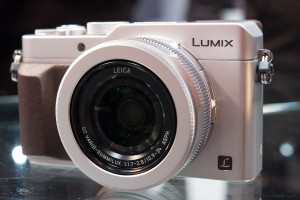Continuing the Day 2 coverage of Photokina, we’re off to Panasonic, to se what they’ve put together for this year. There were a number of releases from Panasonic, though nothing earth shattering. Or was there? Let’s dive in with the LX100

The Panasonic LX100 is Panasonic’s foray into large sensor compact cameras. The LX line has always had good quality, but used smaller sensors. Meanwhile, Sony with their RX100 line and RX1, Fuji with the X100 series and Sigma with their APS-C compacts have been staking out this niche. Panasonic responds by skipping the 1″ sensor and sticking a 4/3 sized sensor in the camera. In order to keep the camera as small as possible, they’ve made the lens cut off a bit of the sensor and used a regular 4/3 sensor as a multi-aspect sensor. As such, the camera has a 2.2x crop factor and a bit more than 12 megapixels. Still, the image quality should be stellar. Of course, I was unable to use my memory card in the LX100, but I did spend a significant amount of time with the camera.
The body is magnesium with a small but comfortable grip on front. It feels rather nice in the hand. It’s not a super small body, being a fair bit larger than an RX100, but it should still easily fit in a jacket pocket. This is all the more impressive considering the range and speed of the lens. The camera features a 24-75mm equivalent lens with an f/1.7 to f/2.8 aperture. On a sensor this large, that will allow for very good image quality in dimmer light and even reasonable subject separation and shallow depth of field.
Panasonic has laid out the controls in a manner that is quite different from other Panasonic cameras, but will be instantly familiar to anyone who’s used a Fuji X camera. In fact, the controls are almost identical to the Fuji X-E2 or X100T. There is a shutter speed dial on top, an aperture ring and a dedicated exposure compensation dial. Third stop shutter speeds are selectable by using the rear dial. I personally love this control scheme, so I enjoy seeing on more cameras, though Fuji may be casting a disapproving glance at Panasonic. That said, it’s not like Fuji patented these controls..they’ve been around for decades on older film cameras. There is also a switch on the lens barrel to switch between manual and autofocus modes, and I did find this switch difficult to engage due to its close proximity to the body.

The camera features an electronic viewfinder that is fairly large, but unfortunately is lower quality than the ones found in, say, the GX7. It appears similar to the viewfinder in the GH2, though it’s a 16:9 aspect ratio and as such will show bars on the sides when shooting in 3:2 or 4:3. Despite not being up to more recent EVFs in Panasonic bodies, it still is a nice finder, especially in such a small camera.

The LX100 is responsive and focuses quickly. The only slow thing about the camera is that zooming with the toggle switch is quite leisurely. Manual focus is a breeze with the auto enlarging patch and focus peaking. It’s easy, clear and accurate. I can’t judge absolute image quality due to not seeing full resolution files, but looking at the rear LCD, the lens on the LX100 seems to be very good, with excellent contrast and color and good sharpness. Use with flash is also great, as it has a sync speed of 1/2000s with the lens’ leaf shutter. The sensor quality is a known entity, though, and should be similar to other recent Panasonic Micro 4/3 cameras. The LX100 has the potential to be a great all-in-one small camera.






Leave a Reply